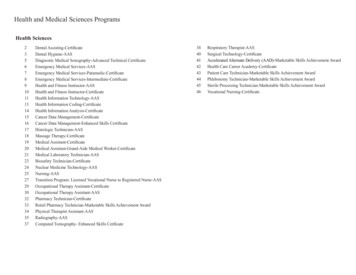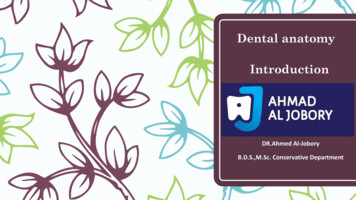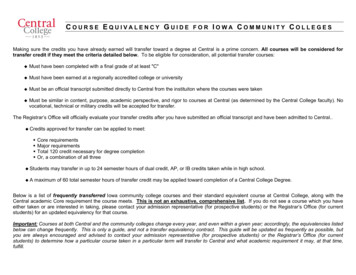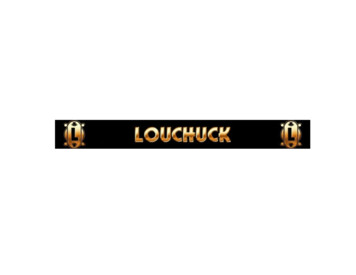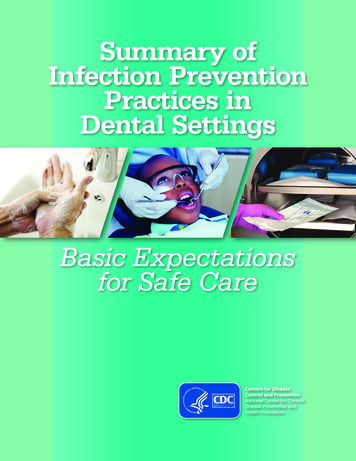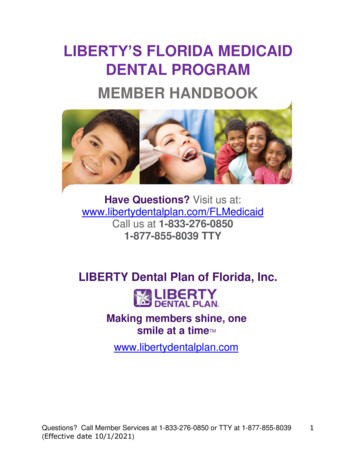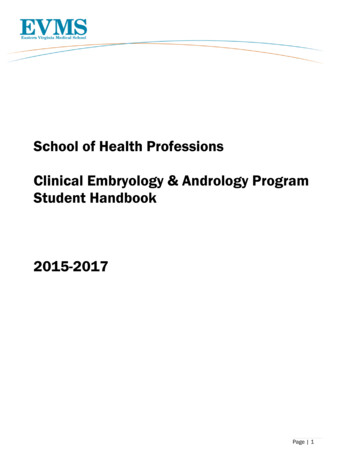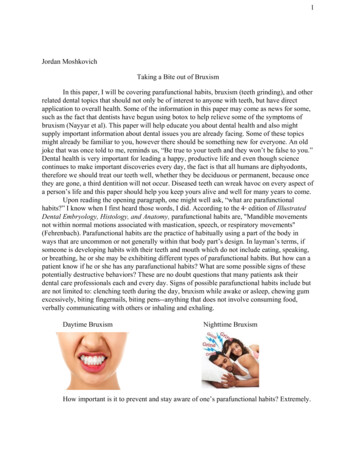
Transcription
1Jordan MoshkovichTaking a Bite out of BruxismIn this paper, I will be covering parafunctional habits, bruxism (teeth grinding), and otherrelated dental topics that should not only be of interest to anyone with teeth, but have directapplication to overall health. Some of the information in this paper may come as news for some,such as the fact that dentists have begun using botox to help relieve some of the symptoms ofbruxism (Nayyar et al). This paper will help educate you about dental health and also mightsupply important information about dental issues you are already facing. Some of these topicsmight already be familiar to you, however there should be something new for everyone. An oldjoke that was once told to me, reminds us, “Be true to your teeth and they won’t be false to you.”Dental health is very important for leading a happy, productive life and even though sciencecontinues to make important discoveries every day, the fact is that all humans are diphyodonts,therefore we should treat our teeth well, whether they be deciduous or permanent, because oncethey are gone, a third dentition will not occur. Diseased teeth can wreak havoc on every aspect ofa person’s life and this paper should help you keep yours alive and well for many years to come.Upon reading the opening paragraph, one might well ask, “what are parafunctionalhabits?” I know when I first heard those words, I did. According to the 4 edition of IllustratedDental Embryology, Histology, and Anatomy, parafunctional habits are, "Mandible movementsnot within normal motions associated with mastication, speech, or respiratory movements"(Fehrenbach). Parafunctional habits are the practice of habitually using a part of the body inways that are uncommon or not generally within that body part’s design. In layman’s terms, ifsomeone is developing habits with their teeth and mouth which do not include eating, speaking,or breathing, he or she may be exhibiting different types of parafunctional habits. But how can apatient know if he or she has any parafunctional habits? What are some possible signs of thesepotentially destructive behaviors? These are no doubt questions that many patients ask theirdental care professionals each and every day. Signs of possible parafunctional habits include butare not limited to: clenching teeth during the day, bruxism while awake or asleep, chewing gumexcessively, biting fingernails, biting pens--anything that does not involve consuming food,verbally communicating with others or inhaling and exhaling.th Daytime BruxismNighttime BruxismHow important is it to prevent and stay aware of one’s parafunctional habits? Extremely.
2According to Dentistry by Design, parafunctional habits can “lead to a variety of mouthdisorders, making them the most destructive cause of wear on teeth” (Chirillo, 2016). In hisjournal article “Occlusion, Function, and Parafunction” Dr. Steven D. Bender reveals that theprimary cause of tooth wear is not eating or chewing of food, but in fact the result ofparafunctional habits such as bruxism and jaw-clenching. He reports that the development ofheadaches and severe migraines may well be from these same parafunctional habits (Bender).Sounds to me like parafunctional habits, are definitely something everyone should be aware of,right? And thus, began my research into bruxism “They certainly give very strange names to diseases” - PlatoSadly, bruxism, is a condition from which too many people around the world suffer. Veryfew people truly understand the profound implications of this odd, seven-letter word. Bruxism isdefined as, “the habit of unconsciously gritting or grinding the teeth especially in situations ofstress or during sleep” (Merriam-Webster).According to Bender, bruxism can lead to pain andother dental problems. Bruxism puts enormous strainon the teeth, generating up to “60 percent of the forcegenerated during voluntary maximum clenching priorto sleep” and can exert nearly 1,000 pounds for forceper square inch (Bender).Because of this, Bender notes, one should not besurprised at the extensive damage to the teeth thatbruxism causes. Research shows that bruxism isdirectly related tooverly sensitiveteeth, breakage ofteeth, andloosening of teethfrom the gums(Bender).
3Bruxism can cause attrition, abfraction and gum recession. Attrition can be defined as theloss of tooth tissue, due to tooth-to-tooth contact, that can occur especially in patients sufferingfrom bruxism.Sleep among other anxiety ridden activities like work, paying bills, and family concerns,cause a greater risk of bruxism. Because bruxism often happens during sleep, people can developpainful and potentially debilitating symptoms without being aware of the root cause andtherefore being able to adequately address it. Bruxism can happen to people of all ages, races,genders, and ethnicities. That being said , “prevalence of bruxism tends to decrease with age,with the highest prevalence during childhood and the lowest in people over 65” (Falace). As discussed, there are two types of bruxism. Bruxism which occurs during the day andbruxism that occurs while asleep (seen on the previous page). Bruxism during periods when theperson is awake most typically manifests itself as “tooth clenching or tapping and jaw-bracing”often without the teeth coming into contact; when people with bruxism are awake they rarelyengage in grinding of their teeth (Bender). However, when night comes, everything changes.Sleep bruxism, as noted above, is much more intense and potentially damaging to dental health.Research shows that sleep bruxism affects one out of five people, with women more prone todeveloping the condition than men (Bender). Experts believe that sleep bruxism is a cyclicalprocess that is associated with an increase in heart and brain activity during the night and tendsincrease and decrease at regular intervals while a person is sleeping. Sleep bruxism occurs in“clusters” followed by spaces of time during which a person’s jaw is relaxed and he or she is notengaged in bruxism (Bender).
4The image above is comparing the normal occlusion of a person without bruxism on theleft side, and on the right, we are able to see a typical example of what the occlusion patternlooks like when someone is grinding their teeth. What is occlusion? Occlusion means, the fittingtogether of the lower arch (mandible) with the upper arch (maxilla) while the jaws are closed.Bruxism in Children“It is easier to build strong children than to repair broken men”- Frederick DouglassIf your child has bruxism-like symptoms, it is important to address this issue early on,rather than later in time. Research shows that the “ incidence of teeth grinding noises during sleepin children younger than 11 years of age is between 14 and 20 percent” furthermore, dentists findsigns of bruxism in “approximately 10 to 20 percent of children” (Bender) . With these statistics,it is clear bruxism is not a matter to be overlooked in a child's dental health. Dental health careprofessionals are still unclear on the precise causes of bruxism in children, although as is the casewith adults, stress and tension can contribute to children developing the condition( Dombrowski). Other factors can also lead to bruxism in children including teeth that are not inproper alignment, dental pain of one form or another; childhood bruxism can also be the result of“ hyperactivity, cerebral palsy or even a reaction to common medications” ( Dombrowski). Thesymptoms of childhood bruxism are very similar to those of adults who suffer from the samecondition. Children who grind their teeth often report headaches, ear pain, or soreness in theirfaces and/or jaws. Dentists advise parents to be especially aware of signs of bruxism such aschipped teeth or worn enamel which can cause/lead to more permanent issues once a child’sadult teeth have come in ( Dombrowski). The enamel is extremely important in long-term dentalhealth because it provides a protective cover for the nerves and blood vessels that allow yourtooth to function in a healthy way. If bruxism goes untreated, it can “erode your teeth throughboth the enamel and dentin to expose the pulp of nerves and vessels. Not only does thiscompromise the integrity of your teeth, but can also lead to intense pain” (Giraki et al). Diagnosing bruxism in children can be challenging for adults who are not familiar withthe condition as children, like adults, might grind their teeth during sleep while being totallyunaware that they are doing so. Also, children lack the vocabulary of adults to preciselycommunicate the nature of pain or other difficulties they might be experiencing due to the effectsof bruxism ( Dombrowski). Dental experts suggest that parents can look in on their children whythey sleep to see if they are engaging in activities that might be associated with bruxism, and toask sibling of the child in question whether or not they are aware of night-time teeth grinding. Ifa parent suspects that their child is experiencing bruxism due to stress or tension, that relaxingnightly routines like story time, warm baths, or calming music might well be beneficial copingstrategies ( Dombrowski). Once someone is diagnosed with bruxism, child or adult, preventativemeasures should be taken to improve the patient's chance of their condition and their overalldental health improving.
5Special Issues of Bruxism and other Parafunctional Habits in Adolescents“The child whose ball doesn’t bounce back” - Paul VioliBecause adolescence is a time when people experience growth spurts and rapidphysiological changes, this age group is particularly vulnerable to temporomandibular disorder(TMD) which can cause them a great deal of pain. Research shows that bruxism is directlyrelated to TMD in people this age (Fernandes, et al 2016). Studies also show that it is importantto differentiate between waking bruxism and sleeping bruxism in order to fully understand thisparafunctional habit’s impact on TMD. As noted, sleep occurs when the subject is unconsciousand grinds his or her teeth, while waking bruxism is more often manifested as jaw-clenching.Even though these types of bruxism differ, they are intricately related and the presence of onegreatly increases the likelihood of the other (Fernandes et al). According to the data, the mostcommon parafunctional habits in adolescents that manifest as bruxism are “nail/pen/pencil/andlip/cheek biting, resting their head on their hand, and gum chewing” (Fernandes et al).Both forms of bruxism are directly linked to the pain of TMD. Aresearch study conducted by Giovana Fernandes and her colleaguesfrom the Universidade Estadual Paulista the Universidade de SãoPaulo in Brazil examined a group of 12-14 year olds experiencingpainful TMD, and sought to find correlations between this conditionand bruxism among other parafunctional habits. This is veryinteresting to me to see that culture and environment do not seem tobe factors in the development of bruxism and related problems;adolescents in Brazil are as likely to show these disorders as much astheir peers in other countries throughout the world.Fernandes and her colleagues began the process by asking theparticipants a series of questions regarding whether or not they hadexperienced facial or jaw pain in the preceding month, how long theyhad been experiencing TMD-related pain, and if they had ever experienced a time when theirjaws seemed stuck or didn’t open all the way. Based on the answers to the questions and amedical examination, the adolescents were sorted into two groups, one with myofascial pain,“athralgia” and osteoarthritis; others without symptoms or without pain became the control group(Fernandes et al). The two groups were also asked if they noticed whether or not they clenchedor ground their teeth at night or if they had been told they do so. They also were asked if theynoticed if they clenched their jaws during the day or engaged in the parafunctional habits likepencil or nail chewing mentioned above.
6(Fernandes et al, 2016).After studying the adolescents and reviewing the data, Fernandes et al found a solidconnection between both types of bruxism, parafunctional habits like pencil chewing and nailchewing, and the onset of painful TMD. Interestingly, they found that these habits led to TMD infemale adolescents more often than males. The reasons for this are not entirely clear, butFernandes and her colleagues found that the “presence of reproductive hormones seems toincrease the risk of developing pain during the time that girls go through puberty” (Fernandes etal). What Fernandes et al also discovered was that feelings of stress tended to increase theincidence of bruxism and parafunctional habits that led directly to painful TMD.The present study confirmed that sleep and awake bruxism, as well as parafunctional habits, arestrongly associated with painful TMD. They found that bruxism can be used as an accuratepredictor of the likelihood of a person developing painful TMD and discovered that “reported“prolonged and sustained, low intensity chewing, clenching, and grinding movements” couldincrease TMD pain not only in adolescents, but in adults as well.One very interesting aspect of the Fernandes study was the “chicken and egg”relationship between quality of sleep and night-time bruxism. On the one hand, stress can lead tobruxism, which in turn leads to a reduced quality of sleep among adolescents and other agegroups. At the same time, when one has a poor night’s sleep one is more likely to engage inbruxism. Given this insight, it is interesting to examine the psychological aspects of bruxism andparafunctional habits and their relationship to stress. I will take a look at this later in the paperand see if stress management techniques or even medications like Zoloft and Xanax can provide
7relief for bruxism, parafunctional habits, and the dental problems that they can lead to. Inconsidering the line from Violi’s poem, “The child whose ball doesn’t bounce back”, if theseissues can be addressed during a person’s childhood or adolescence, he or she might be able toenjoy a life free of these conditions and the resulting pain and oral damage.Treatment of Bruxism“Life is short. Smile while you still have teeth.” - AnonymousDespite the extensive damage that bruxism can cause, health care professionals can offera variety of ways to reduce its impact on oral health and in some cases, alleviate the conditionentirely. The Mayo Clinic notes that in many cases it is not necessary to treat bruxism at all,especially if the symptoms are manageable and are not causing permanent damage. Manychildren outgrow the condition as they age, and a significant portion of adults are not harmingthemselves due to their habitual bruxism. However, in those people for which bruxism is an issueand has the potential to damage their health and quality of life, dentists and others can offer avariety of ways to help treat the condition.“Prepare and prevent, don’t repair and repent.” – AnonymousA simple way to lessen the impact of bruxism in those for whom it is a problem isthrough the use of mouthguard or splint worn at night to prevent damage to the teeth fromgrinding. These devices can be made in either soft or rigid forms, and are custom-made to fit anindividual’s specific dental structure (Mayo Clinic). Most night mouth guards provide enough ofa layer of protection between the maxillary and mandibular arches, which protect during nightbruxation. When suggesting a nightguard, a dentist will usually suggest to their patient use acustom nightguard instead of a generic store bought one, to ensure a more secure and snug fit.Custom nightguards can range from 300- 500. Some may see this price tag and think,“how can a piece of rubber be worth my hard-earned money?!” Well, the amount of money
8being saved over the years from not having to add additional dental visits alone more than justifythe cost. The benefit nightguards can provide on a child’s occlusion and overall dental healthalso represent a very worthwhile investment. The likelihood of bruxism decreasing over time isgreatly impacted if proper care and preventative measures are taken. Bruxism is not the onlyreason someone should wear a nightguard to help better protect their teeth while they sleep,however, patients suffering from bruxism who used a nightguard saw their grinding episodes hadimproved.The Mayo Clinic indicates that in more severe cases, realignment of the teeth might be aneffective treatment in order to minimize the surface contact that can damage teeth. When theeffects of bruxism have resulted in a patient having difficulty chewing or experiencing toothsensitivity or pain, a dentist “may need to reshape the chewing surfaces of your teeth or usecrowns. In certain cases, your dentist may recommend braces or oral surgery” (Mayo Clinic).Other non-invasive therapies such as meditation, massage, psychological counseling, orother stress-reducing interventions that have the potential to reduce bruxism can be highlyeffective. Furthermore, those with bruxism can also be trained to hold their mouth and jaws inproper position in order to minimize the damaging effects of bruxism (Mayo Clinic).Typically, medications are ineffective in treating bruxism, according to the Mayo Clinic,however some doctors might suggest the short-term use of muscle relaxants to decrease jawtension. In severe cases, as noted earlier, a physician or dentist might use botox injections inthose patients with severe and damaging muscle-related bruxism for whom other therapies areinappropriate or ineffective (Mayo Clinic).In their study “ Therapies for bruxism: a systematic review and network meta-analysis”Mesko et al (2016) are currently seeking to find out which of the many available therapiesincluding medication, physical therapy, mouthguards, and psychotherapy among others was themost effective in treating bruxism in adults. First, they will investigate the causes of bruxism,many of which are discussed in greater detail in this paper. They have found that smoking,certain medications, and problems with breathing can play an important role in the developmentof bruxism, however they agree with the majority of the dental literature which indicates thatbruxism is primarily “abnormal rhythmic mandibular movements.caused by [the] central andautonomic nervous system (Mesko et al 2016). They note that in the past, stints designed tofacilitate “occlusal equilibration” or in layman’s terms, the alignment of the upper and lowerteeth in an even pattern throughout the mouth did not seem to be effective because they did notaddress or remediate the root causes of bruxism and instead merely lessened the symptoms thatthe patient might be experiencing (Mesko et al 2016). Other therapies like relaxation,biofeedback and cessation of caffeine use and relaxation techniques before bedtime do not seemto have any real effect on controlling muscular activity during sleep nor on autonomic activity ofthe muscles. Are these therapies useless? Not at all, because they are of limited effectiveness inreducing patients’ pain and symptoms, however as a long-term remedy, they did nothing aboutthe initial issue. Nonetheless, Mesko et al’s research is a stepping stone in the right direction.Mesko et al are evaluating other therapies that have shown promise in treating bruxism.They note that the combined use of a medication known as Clonidine, primarily used to treathigh blood pressure, ADHD, and anxiety disorders along with “mandibular advancementappliances” has been successful at controlling the muscular activity associated with bruxism,however they stress that more follow-up research is needed to truly test the efficacy of this
9approach (Mesko et al 2016). Another alternative treatment of note in the study is the use ofbotulinum toxin injection into the muscles responsible for chewing, however as is the case withother therapies, more research is needed to determine the long-term success rate of this approachas well as more time to collect data on possible negative side-effects, which this paper willexplore in greater detail. Mesko et al notes that the most successful treatment of bruxism will beone that controls the patient’s pain, reduce tooth wear, and address the root causes of thisparafunctional activity. Because as many as one-third of adults have bruxism, therefore it isextremely important for both dentists and patients to be able to choose the best treatment optionbased on a thorough study of current methods which are “based on evidence and not only onexpert’s opinion” (Mesko et al 2016).Mesko et al are in the process of conducting their study using a population of adults whohad received a diagnosis of bruxism and compared the effectiveness of soft tissue surgery,medications, botulinum injections, electric stimulation of the muscles, along with other physicaland psychological treatments to see which approach, or combination of approaches, produced thebest results across a large sample. The considered outcomes will be assessed in terms of primaryeffects, which they measure in terms of duration and intensity of muscular activity; secondaryeffects such as improvement in the quality of sleep, quality of the patients’ lives, and the level ofstress they experienced; taking into consideration the side effects including the cost and timespan of the treatment, and how well the patients complied with each of their prescribed therapies(Mesko et al 2016). Ongoing studies like this are vitally important in enabling dentists to makestrides forward in the treatment of bruxism. Continuing to develop an evolving body of literatureon this disorder, while continuing to search for new and better therapies is extremely importantas dental health care advances. As is the case with the treatment of other disorders and diseases,the work that Mesko et al and others are doing might find that combining therapies will providethe most favorable outcome for those suffering from bruxism.“As laser-bright moments; diamond-hard memories; crisp and clear. A future lived, a futuresavored” - Robert J. SawyerLasers?One such innovative new approach is the combined use of low-level laser irradiation andmedications to treat the pain caused by bruxism and other dental parafunctional activities.In their study “Comparative Study of the Physiotherapeuticand Drug Protocol and Low-Level Laser Irradiation in theTreatment of Pain Associated with TemporomandibularDysfunction” Cavalcanti et al (2016) investigated the use oflow-level laser therapy (LLL) and compared it with with theuse of “physiotherapeutic and drug protocol” in a populationof women between the ages of twenty and fifty who aresuffering from bruxism. They found that, indeed, the use oflasers can be helpful in reducing the pain that comes alongwith TMD, although to address the concerns of Mesko et al
10(2016), LLL is better at addressing the symptoms of bruxism and other parafunctional activitiesthan it is as eliminating the causes of these disorders. Cavalcanti et al note that in eight out of tenpatients, the pain associated with TMD and bruxism is caused by spasms of the muscles used forchewing which are created by fatigue, stress, and overuse from parafunctional habits initiating avicious cycle which they and other researchers have tilted the “pain-spasm-pain syndrome”(Cavalcanti et al 2016). As a person experiences TMD pain, he or she tenses the muscles in theaffected area, increasing the likelihood of bruxism and igniting more pain. The greater the pain,the higher levels of muscular tension. Cavalcanti et al’s thesis is that LLL can relax thesepowerful muscles, reduce inflammation in the area, thereby lessening the amount of pain that apatient experiences.In their research, Cavalcanti et al compared a group of people receiving LLL therapywith another who was treated with hot packs three times a day along with medications designedto relax the facials muscles and to reduce inflammation in the affected area. A third group wasthe placebo group, who received “laser” therapy in the form of a bright halogen light that was nota laser at all and had been determined to have no effect, good or bad, on the pain associated withbruxism and TMD. Each of the women being studied self-reported moderate to severe pain dueto bruxism. Their results found that using LLL has a muscle relaxant did in fact significantlyreduce the pain that the women in the study group experienced. Cavalcanti et al found that “painbegan to decrease at the end of the first week for patients who received LLL” and “moregradually at the end of the second week” for those being treated with hot compresses andmedications. As might be expected, those in the placebo group also reported a lessening of theirpain, which Cavalcanti et al attributed to “anxiety and depression control” but also found thateveryone in placebo group was still having pain at the end of the trial period, while the LLL andheat/medication groups experienced significant reduction in pain (Cavalcanti et al, 2016). Theynote that while LLL and the heat/medication protocol achieved similar results, LLL treatment isfar less expensive and that with the introduction of small, portable home units these costreductions could be even more dramatic.“People say I look so happy - and I say, 'That's the Botox” - Dolly PartonBotox and BruxismWhen one thinks of Botox, one often thinks of an aging movie star trying to cheat time ora “Real Housewife of New Jersey” hoping to fool people into thinking she’s the same age as herteen-age daughter. However the mechanisms of Botox that work to remove laugh lines andwrinkles also have serious application in the fields of dentistry and medicine and that includestreating bruxism and other parafunctional habit that cause muscular problems and pain. Botoxworks by blocking nerve impulses and creating a form of paralysis in the area into which it isinjected. Botox is a naturally occurring poison and its paralytic effects are powerful, buttemporary, and those using it must receive ongoing injections. The article “An evidence-basedreview of botulinum toxin (Botox) applications in non-cosmetic head and neck conditions” byPersaud et al (2013) examines some of these uses and sheds light on how Botox can be used totreat bruxism and other causes of TMD pain.According to Persaud et al, pain from clenching the jaws and teeth is
11caused by “chronic nociceptive irritation of the tendons and fascias of the masseter, temporalisand medial pterygoid muscles” (Persaud et al, 2013). Botox, which paralyzed muscles, mightwell be able to relieve this sort of distress, a theory that Persaud et al sought to investigate.Indeed, they found that the use of Botox proved to very effective in by creating atrophy in certainchewing muscles, in the process relieving a patient’s tension and enabling “decompression ofafferent nociceptive neurons through reduction of substance P-mediated neurogenicinflammation” (Persaud et al, 2016). They do warn that Botox must be injected by someoneextremely familiar with its effects as it can lead to the unintended consequence of causing a“frozen smile” by paralyzing certain muscles. Persaud et al found that Botox is particularlyeffective in treating the tension and pain associated with bruxism and is highly effective inreducing “myofascial pain symptoms” in those with bruxism as compared to others in studieswho received placebos in the form of saline water injections (Persaud et al, 2016). Theyconclude that Botox may well be a poison that actually heals rather than killing.Psychology, Stress, Bruxism and Parafunctional HabitsStress has been identified as a major factor in developing bruxism and otherparafunctional habits. When discussing stress it is important to examine not only its sources butalso the effectiveness with which people manage it. Two people can be stuck in maddening rushhour traffic and one can be yelling, screaming, and punching the steering wheel while the othercan be completely calm and accepting of the situation as being out of his or her control. Giventhis it is more accurate to say that stress management plays a significant role in bruxism ratherthan placing the blame on external stress itself. Because people can build theirstress-management skills and coping mechanisms it means they can also play an active role inlessening or even eliminating bruxism and other parafunctional habits that may well bedamaging their oral health. A study conducted by Giraki et al (2010) found that those with themost severe cases of sleep bruxism were also those who tended to deal with stress is anon-productive or negative fashion.As early as 1975 researchers began to notice a direct correlation between bruxism and “the number of occupational health care and dental visits” and researchers found that “bruxismmay reveal ongoing stress in normal work life” (Giraki et al). Interestingly, Giraki andcolleagues found that more ambitious, hard-driving people were at higher risk of developingbruxism. Laboratory experiments have found that the “relationship between emotional stress andbrux-like activity of.masseter muscles have also suggested a positive correlation” (Giraki et al).Those studied by Giracki et al reported that they were not good at managing stress, and describedthemselves as being reactive to situations as opposed to being in control. This informationprovides a great deal of insight into the development of bruxism in all age groups, particularlyhigh school and college students who report that they find themselves under a great deal ofstress. Bruxism might well be a product of the fact that although young people do experiencestress, they may not have yet had the opportunity to develop the effective coping mechanismsthat older, more experienced people have. Having said that, it is clear the people of all ages havevarying degrees of
Dental Embryology, Histology, and Anatomy, parafunctional habits are, "Mandible movements not within normal motions associated with mastication, speech, or respiratory movements" (Fehrenbach). Parafunctional habits a
